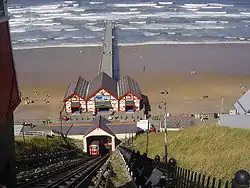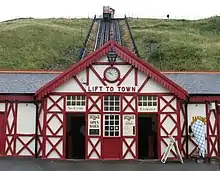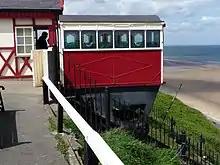Saltburn Cliff Lift
The Saltburn Cliff Lift is a funicular railway in Saltburn-by-the-Sea, Redcar and Cleveland in the ceremonial county of North Yorkshire, England. It provides access to Saltburn Pier and the seafront from the town. The cliff lift is the oldest operating water-balance cliff lift in the United Kingdom.[1][2]
 View from Upper Station | |
 Lower Station | |
| Overview | |
|---|---|
| Locale | Saltburn-by-the-Sea, North Yorkshire, England |
| Transit type | Funicular railway |
| Number of stations | 2 |
| Operation | |
| Began operation | 28 June 1884 |
| Operator(s) | Redcar and Cleveland |
| Technical | |
| System length | 207 feet (63 m) |
| Track gauge | 4 ft 8 1⁄2 in (1,435 mm) |
Saltburn Cliff Lift was constructed between 1883 and 1884 to replace a vertical cliff hoist, designed by John Anderson, which was used to transport passengers up and down the steep north-facing cliff between the town and the pier. It improved access for tourists to the seafront and beach. Designed by George Croydon Marks for the manufacturer Richard Tangye, the cliff lift has a height of 120 feet (37 m) and a track length of 207 feet (63 m), resulting 71 per cent incline. A pair of 12-person cars, each fitted with a 240-imperial-gallon (1,100 L) water tank, run on parallel standard gauge tracks; by removing or adding the water to their tanks, movement is achieved, regulated by a brakeman at the top.
The lift opened on Saturday 28 June 1884. The original cars have been replaced with aluminium counterparts and the top station restored, but little of the underlying mechanism has been changed since it was installed. Owned since the Second World War by the unitary authority of Redcar and Cleveland, the lift remains in regular use between March and October each year. It is one of Saltburn's most popular tourist attractions.[3] Reportedly, the service was being used by an estimated 150,000 passengers per year by the twenty-first century.[4]
Cliff hoist 1870–1883
On 17 August 1861, the Stockton and Darlington Railway arrived in Saltburn from Redcar. Its passenger services prompted considerable growth in the numbers of day trippers and holiday travellers.[5] The boom in tourism stimulated local businesses to capitalise on the new demand, resulting in various new ventures and projects, including Saltburn Pier, which was completed during 1869. Access to the pier from the town via the steep cliff top was relatively difficult and there was a demand for the provision of a better means of reaching it.[6]
The Saltburn Pier Company contracted John Anderson, who had designed the pier, to engineer a solution. He designed the wooden cliff hoist.[6] The hoist, in a tapering lattice timber tower, was moved using water power. A balance tank attached to the wooden lift cage was filled or emptied, For stability, ropes were run inside the tower between the cliff top and beach level.[6]
On 1 July 1870, the cliff hoist was opened, roughly 14 months after the pier.[6] Passengers approached the hoist top via a narrow walkway supported on timber trestles jutting from the cliff face, boarded the cage and descended 120 feet (37 m). Movement was achieved by adding water to its counterbalance tank. To achieve movement in the other direction, water was drained from the tank.[1]
Cliff lift 1884–present
Background
Following the sale of Saltburn Pier Company to the Middlesbrough Estate in August 1883, the new owners commissioned an inspection of the Cliff Hoist by independent engineers. The inspection led to the structure being condemned because of rotten timbers.[5] The lift had developed a tendency to stop halfway demonstrating its unreliability.[6] It was demolished in late 1883.[7]
The owners commissioned Sir Richard Tangye's company, who had built the earlier Scarborough funiculars, two vertically-inclined water-powered funicular railways, to build a replacement.[6] Tangye appointed the engineer George Croydon Marks as the head of the lift department and he took charge of the design and installation at Saltburn.[8] Marks designed and constructed the funicular with a height of 120 feet (37 m) and a track length of 207 feet (63 m), resulting in a 71 per cent incline.[1]
Elements of the Saltburn Cliff Lift were sourced from multiple companies. Most of the machinery was provided from Tangye, the cars were fabricated by the Birmingham-based rolling stock manufacturer Midland Railway Carriage and Wagon Company, and the gas-powered water pump was produced by Manchester-based engineering firm Crossley Brothers.[6]
Design and operational theory

As built, the funicular had a pair of 12-person cars, each of which was equipped with a 240-imperial-gallon (1,100 L) water tank. They ran on parallel standard gauge 4 ft 8 1⁄2 in (1,435 mm) funicular tracks. Double steel wire ropes were attached to both cars, and the car's movement was controlled by a brakeman at the upper station via an iron winding wheel with double grooves for the running cables and a flange for braking.[6]
The car at the top station has its water tank filled until its mass exceeds the mass of the car at the bottom. Then the car can travel down the incline, counterbalanced by the mass of the other car, which travels to the top; movement is regulated by the brakeman, who controls the speed of travel. When the car reaches the bottom, its water is released, reducing the mass of the lower car, and pumped back to the top. Water is sourced from a nearby spring and stored in a pair of reservoirs, one, capable of storing up to 136,380 litres, is near the lower station, and the other, up to 84,100 litres, is at the cliff top.[6]
Operations
Saltburn Cliff Lift first opened on Saturday 28 June 1884, but there followed a period of inconsistent operation. The launch of the Cliff Lift may have contributed to the pier company extending the pier.[1]
_and_coming_down_(left)_-_geograph.org.uk_-_1579590.jpg.webp)
The original cars, which seated 12 passengers, had stained-glass windows but when the Cliff Lift was refurbished during 1955, the replacement car bodies had plain glass.[6] The aluminium cars introduced during 1979 were modelled on the original design. The stained-glass windows were reinstated in 1991.[1] The wooden bodies of the passenger cars were refurbished and "Victorianised" during 2011 by Stanegate Restorations of Haltwhistle.[9]
Owned since the Second World War by the unitary authority of Redcar and Cleveland,[10] Marks' design for the cliff lift was so good that, that beyond routine maintenance and the occasional refurbishment, little of the mechanism has been changed since its installation during 1884.[7] During winter 1921-2, the track gauge was changed from 3' 9" to 4' 2 1/2".[6] In 1924, an AC electrically-operated water pump was installed to replace the 1913 DC generator and pump arrangement, which had earlier replaced the coal gas-fuelled four-cylinder Crossley-built internal combustion engine-driven water pump.[1]
Between 1997 and 1998, the cliff lift was refitted to comply with modern safety standards.[6] During 1998, the main braking wheel was replaced for the first time by a hydraulic braking system to complement the original band braking/driving system.[1] From 19 September 2010 to 11 April 2011, the funicular underwent restoration, reportedly costing around £30,000.[11] In spring 2014, the top station was refurbished and restored it to its original design.[12] During late 2017 and early 2018, the cliff lift was closed for a £500,000 restoration programme following an in-service breakdown; mechanical elements were replaced including all sleepers which were changed to steel to prolong the life, rails, cast iron items which were re-cast from the original components, emergency Scotch Timber braking system along with electric control systems and some lighting.[13][4] During its refits and restoration, an emphasis has been placed on retaining original parts; where replacement items have been necessary, they have usually been created in the style of their forbearers.[14][15]
The cliff lift has been closed since March 2020 due to the COVID-19 pandemic.[16]
See also
References
- "Saltburn Cliff Lift". Saltburn-by-the-Sea. Retrieved 5 June 2010.
- "Saltburn Cliff Lift". This is Redcar & Cleveland. R&CC. Archived from the original on 14 April 2016. Retrieved 31 January 2016.
- "Saltburn's Victorian town celebrates its 150th birthday." BBC News, 19 August 2011.
- Brown, Mike. "133-year-old Saltburn cliff lift to close for £400k refurb after breaking down three times in a year." Teesside Live, 26 September 2017.
- Delplanque, Paul (4 January 2010). "Saltburn Cliff Lift...Then and Now". Tees Gazette. Retrieved 5 June 2010.
- "Saltburn Funicular Railway". engineering-timelines.com. Retrieved 20 June 2018.
- "Saltburn Cliff Lift". BBC Tees. Retrieved 5 June 2010.
- Cooper, David. "A Brief History and Explanation of Technology Babbacombe Cliff Railway". Friends of the Babbacombe Cliff Railway. Archived from the original on 2 October 2010. Retrieved 4 June 2010.
- "Saltburn cliff lift carriage refit complete". BBC News. BBC. 22 April 2011. Retrieved 20 January 2014.
- Love, Laura (26 June 2014). "Iconic Saltburn Cliff Lift set to celebrate its 130th birthday". Gazette Live. Retrieved 31 January 2016.
- "Saltburn cliff lift carriage refit complete." BBC News, 10 April 2011.
- Morgan, Mike. "Anger as Saltburn’s historic cliff lift ticket kiosk faces demolition." Teesside Live, 8 December 2012.
- Site Manager Rapid Consulting Engineers, main contractors for tramway restoration 2017 - 2018
- Robson, Dave. "Original 1884 Saltburn Cliff Lift parts found as overhaul stays on track for summer reopening." Teesside Live, 12 April 2018.
- "Saltburn cliff tramway 'likely' to remain closed for summer." BBC News, 19 May 2018.
- Metcalfe, Alex (18 March 2020). "Cliff lift, libraries & youth clubs closed in Redcar and Cleveland". TeessideLive. Retrieved 4 February 2021.
External links
| Wikimedia Commons has media related to Saltburn Cliff Lift. |